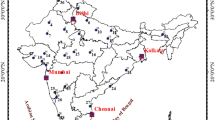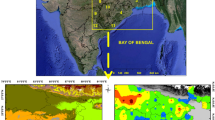Summary
Different measures of variability of precipitation are discussed and it is concluded that it is preferable to apply therelative intersequential variability in cases when overall trends are feared in the records. 127 stations in Sweden have been studied for the period 1901–1950 as to the relative interannual variability of precipitation. For a selection of these stations other measures have also been calculated and a comparison has been made between the coefficient of variation and the intersequential variability. As the relation between these measures varies with the existence of serial correlations in the records the serial correlation coefficient for a lag of one element has been calculated. The value of the coefficient has indicated the existence of trends in certain areas of Sweden generally in agreement with earlier investigations byÅngström.
The geographical distribution of the relative interannual variability in Sweden is discussed and also the distribution of anomalies of relative variability compared with the world's normal curve completed byConrad. It is shown that the relationship between relative variability and precipitation amount for Swedish stations can be expressed by a hyperbolic function deviating fromConrad's world normal curve only by an additive constant.
Zusammenfassung
Der Verfasser erörtert verschiedene Maße für die Variabilität des Niederschlages und kommt zu der Feststellung, daß in den Fällen, in denen eine einseitige Tendenz in den Beobachtungsreihen zu befürchten ist, die Verwendung derrelativen reiheninternen Variabilität am geeignetsten ist. 127 Stationen in Schweden sind für die Periode 1901–1950 im Hinblick auf die relative interannuelle Variabilität des Niederschlags untersucht worden. Für eine Auswahl dieser Stationen wurden auch andere Maße berechnet und der Schwankungskoeffizient mit der reiheninternen Variabilität verglichen. Da die Beziehung zwischen diesen Maßen mit dem Auftreten von Serienkorrelationen in der Beobachtungsreihe variiert, wurde der Serienkorrelationskoeffizient für eine Verschiebung eines Elements berechnet. Die erhaltenen Werte des Koeffizienten deuten auf das Vorhandensein gesetzmäßiger Tendenzen in gewissen Gebieten Schwedens hin und stehen im allgemeinen in guter Übereinstimmung mit älteren Untersuchungen vonÅngström.
Die geographische Verteilung der relativen interannuellen Variabilität in Schweden sowie die Verteilung der Anomalien der relativen Variabilität, verglichen mit der vonConrad aufgestellten Weltnormalkurve, werden erörtert. Schlie\lich wird gezeigt, daß es möglich ist, den Zusammenhang zwischen relativer Variabilität und Niederschlagsmenge für schwedische Stationen durch eine hyperbolische Funktion zu beschreiben, die vonConrads Weltnormalkurve nur durch eine additive Konstante abweicht.
Résumé
L'auteur mentionne différentes mesures de la variabilité des précipitations et conclut qu'il est préférable d'appliquer la variabilité relative interséquentielle lorsqu'une tendance unilatérale des séries d'observations est à craindre. Il a étudié la variabilité relative interannuelle des précipitations pour 127 stations suédoises (1901/50) ainsi que d'autres mesures de variabilité pour un choix restreint de stations et il a comparé le coefficient de variation à la variabilité relative interséquentielle. Comme la relation entre ces mesures varie avec l'existence de corrélations de série dans les séries d'observations, le coefficient de corrélation de série a été calculé pour un déplacement d'un terme; la valeur de ce coefficient indique l'existence de tendances générales dans certaines régions de Suède, ce qui confirme les résultats anciens deÅngström.
La distribution géographique de la variabilité relative interannuelle en Suède ainsi que celle des anomalies de la variation relative comparée à la courbe normale mondiale dressée parConrad fait l'objet d'un examen. Enfin on montre qu'il est possible d'exprimer la relation entre la variabilité relative et la quantité de précipitations en Suède par une fonction hyperbolique qui ne diffère de la courbe normale deConrad que par une constante additive.
Similar content being viewed by others
References
Ångström, A.: Nederbördsklimatets ändring i nuvarande tid (The Variation of the Precipitation Climate in Present Time). Medd. St. Met. Hydr. Anst. Ser. upps. No. 37 (1941).
Bergsten, K. E.: Some Characteristics of the Dispersion of the Annual Precipitation in Sweden During the Period 1881–1940. Lund Stud. Geogr. A. Phys. Geogr., No. 1 (1950).
Conrad, V.: The Variability of Precipitation. Monthly Weather Rev.69, 5 (1941).
Conrad, V., andL. W. Pollak: Methods in Climatology, 2nd Ed. Harvard University Press (1952).
Landsberg, H.: Statistical Investigations into the Climatology of Rainfall on Oahu. Met. Monogr.1, No. 3 (1951).
Longley, R. W.: Measures of the Variability of Precipitation. Monthly Weather Rev.80, 111 (1952).
—: Variability of Annual Precipitation in Canada. Monthly Weather Rev.81, 131 (1953).
Pollak, L. W.: On the Systematic Influence in Series of Annual Rainfall Totals. Dep. of Industry and Commerce, Met. Service, Geophys. Publ. Dublin3, No. 5 (1951).
Wallén, C. C.: Some Characteristics of Precipitation in Mexico. Geogr. Ann. Stockh.37, 51 (1955).
Author information
Authors and Affiliations
Additional information
Dedicated to Dr.Anders K. Ångström on the occasion of his 70th birthday.
With 5 Figures
Rights and permissions
About this article
Cite this article
Wallén, C.C. Variability of annual precipitation in Sweden. Arch. Met. Geoph. Biokl. B. 9, 113–123 (1958). https://doi.org/10.1007/BF02242904
Issue Date:
DOI: https://doi.org/10.1007/BF02242904




